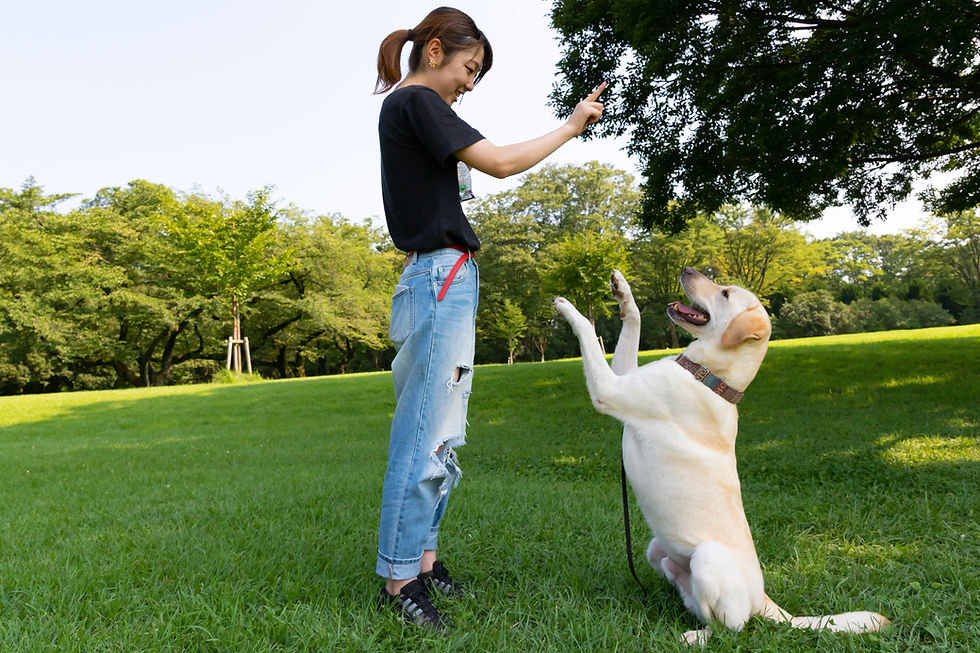Fluency in Behavior Performance: Enhancing Speed, Accuracy, and Reliability
- k9HS - Carlos F Morales

- Mar 10
- 4 min read
Updated: Oct 2

Hello hello, Trainers! Carlos here.
Fluency in behavior performance is a fundamental goal in professional dog training. A fluent behavior is executed with speed, accuracy, and reliability, regardless of distractions or environmental changes. When fluency is achieved, a behavior becomes automatic and requires minimal prompting, demonstrating resilience even when reinforcement is infrequent.
Developing fluency is not just about teaching a behavior but refining it to ensure consistent performance in real-world scenarios. This requires a structured approach to reinforcement and strategic fading techniques to prevent reinforcement dependency while maintaining strong behavioral responses.
Key Components of Fluency

Fluent behaviors are characterized by three essential attributes:
Speed: The dog responds to cues without hesitation.
Accuracy: The behavior is performed correctly and consistently.
Reliability: The behavior remains strong across various settings, distractions, and reinforcement schedules.
These components allow dogs to integrate trained behaviors seamlessly into their daily lives, ensuring they respond appropriately in diverse situations. Achieving fluency requires systematic reinforcement adjustments to maintain performance without creating dependence on constant rewards.
Why Strategic Reinforcement Fading Matters
Reinforcement is essential for learning, but its application significantly impacts behavior longevity. Gradual reinforcement fading is critical to building fluency while preventing over-reliance on external rewards.
Here’s why structured reinforcement fading is important:
Prevents Reinforcement Dependence: Ensures behaviors persist even in the absence of visible rewards (Sidman, 1960).
Enhances Long-Term Retention: Intermittent reinforcement strengthens behavior durability (Ferster & Skinner, 1957).
Promotes Intrinsic Motivation: Transitioning to social reinforcers, play, or functional rewards sustains engagement (Harlow, 1950).
Refines Speed & Accuracy: Variable reinforcement schedules encourage faster, more precise responses (Skinner, 1953).
The Three Phases of Reinforcement for Fluency

1️⃣ Phase 1: Continuous Reinforcement (CRF) for Learning
When introducing a new behavior, reinforcing every correct response is essential to establish strong cue-response associations.
✅ Implementation Strategies:
Reinforce every successful response to create clarity and motivation.
Example: Rewarding every sit during the initial training stage.
🚨 Limitations of CRF:
❌ Low resistance to extinction—behavior may fade if reinforcement stops abruptly.
❌ Increased reward dependency—dogs may hesitate if treats are not visible.
✅ Criteria for Transitioning to Phase 2:
The dog performs the behavior correctly 80% of the time in familiar environments.
The cue reliably elicits an immediate response, even without visible reinforcement.

2️⃣ Phase 2: Transitioning to Fixed & Variable Reinforcement
Once behavior consistency is established, reinforcement should be systematically reduced to enhance fluency.
✅ Implementation Strategies:
Fixed Ratio (FR): Reinforce after a set number of responses (e.g., every 2nd or 3rd sit) to build endurance (Mazur, 1986).
Variable Ratio (VR): Introduce unpredictability by reinforcing randomly (e.g., after 2, then 5 sits), increasing persistence and motivation.
🔹 Why VR Reinforcement Works: Variable schedules create highly durable behaviors—similar to reinforcement patterns observed in human gambling behaviors (Nevin, 1992). The unpredictability of reinforcement strengthens resistance to extinction (Skinner, 1953).
✅ Criteria for Transitioning to Phase 3:
The dog consistently performs the behavior without expecting reinforcement after every response.
The behavior remains reliable across various environments and distractions.

3️⃣ Phase 3: Intermittent Reinforcement & Alternative Rewards
At this stage, reinforcement should be strategic and unpredictable to ensure the behavior remains resilient.
✅ Implementation Strategies:
✔ Step 1: Shift to Intermittent Reinforcement → Reward behaviors occasionally to maintain strength while reducing predictability (Staddon & Simmelhag, 1971).
✔ Step 2: Introduce Alternative Reinforcers → Replace treats with real-world reinforcers (e.g., praise, tactile reinforcement, play, or environmental access) (Reid, 2012).
✔ Step 3: Reinforce Only Exceptional Responses → Reward the most precise, enthusiastic, or voluntarily offered behaviors to encourage optimal performance.
✅ Final Fluency Criteria:
The dog responds promptly and accurately across all environments.
Reinforcement is occasional, yet the behavior remains strong and consistent.
The dog reliably performs the behavior without requiring visible treats.
Final Thoughts
Trainers, achieving fluency in behavior performance requires a structured, progressive approach to reinforcement. By strategically transitioning through reinforcement phases, we can create durable, resilient behaviors that withstand real-world challenges.
If you have questions or need guidance on reinforcement strategies, reach out—I’m always happy to collaborate and support your training journey!
Carlos F. Morales - CDBC | CPDT-KA
References
Ferster, C. B., & Skinner, B. F. (1957). Schedules of reinforcement. Appleton-Century-Crofts.
Harlow, H. F. (1950). Learning and reinforcement. Journal of Comparative and Physiological Psychology, 43(5), 289-294.
Mazur, J. E. (1986). Fixed and variable schedules of reinforcement. Journal of Experimental Psychology: Animal Behavior Processes, 12(1), 5-16.
Nevin, J. A. (1992). Behavioral momentum: Theory and applications. Journal of the Experimental Analysis of Behavior, 57(3), 301-316.
Reid, P. J. (2012). Excel-erated learning: Explaining how dogs learn and how best to teach them. Dogwise Publishing.
Sidman, M. (1960). Tactics of scientific research: Evaluating experimental data in psychology. Basic Books.
Skinner, B. F. (1953). Science and human behavior. Macmillan.
Staddon, J. E., & Simmelhag, V. L. (1971). The "superstition" experiment: A reexamination of its implications for the principles of adaptive behavior. Psychological Review, 78(1), 3-43.
Carlos is the head trainer at Canine High School in Long Beach, CA, a force-free Puppy School and Dog School. He is responsible for creating the school's Dog Training System, Curriculum, and Philosophy. In addition to educating his canine students and their human parents, he runs a teaching school that offers apprenticeship and internship programs for aspiring professional dog trainers. He is a Certified Mentor Trainer for several dog training schools and holds certifications with the IAABC and the CCPDT. He lives in Long Beach, CA, in a little house by the beach with his human, his three dogs GoGo, Kiba, Choji, and a sassy cat, Habibti.
.png)





Comments